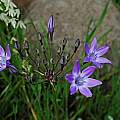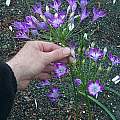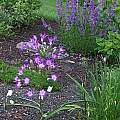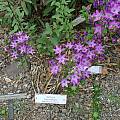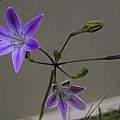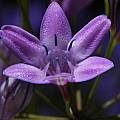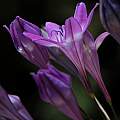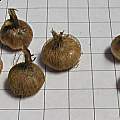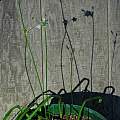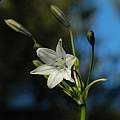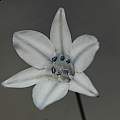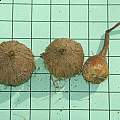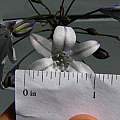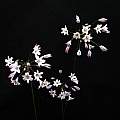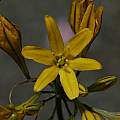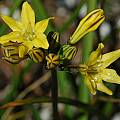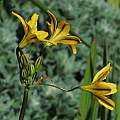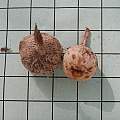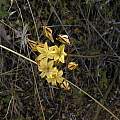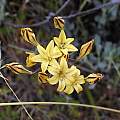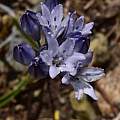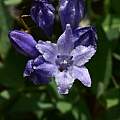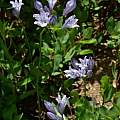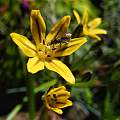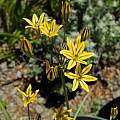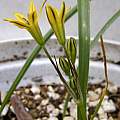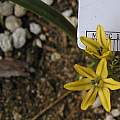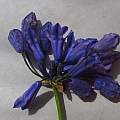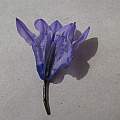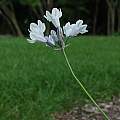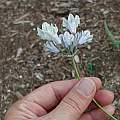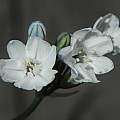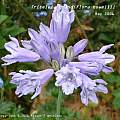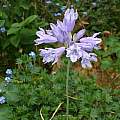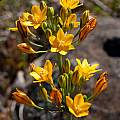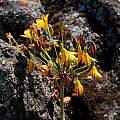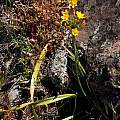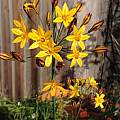Triteleia species a-g are found on this wiki page.
Triteleia Hybrids - Triteleia h-i - Triteleia j-z - Triteleia index
Triteleia bridgesii (S.Watson) Greene is found on dry rocky bluffs and open woods usually in heavy soil in the northern Coast Ranges and the northern and central Sierra foothills of California and into Oregon between 0 and 3000 ft (0-915 meters). The first picture from Mary Sue Ittner was taken in the native area of Bidwell park in Chico, California in April 2006. The second and third were taken by Mark McDonough. He writes: Here are two views of this very beautiful two-toned "Trit". The forms shown here were obtained as bulbs from Jim Robinett, and have proved to be very reliable, showy native bulbs growing here in my New England garden, USDA Zone 5. The last photo is of a specimen contributed by the UC Botanical Garden.
These pictures from Mary Sue Ittner are of seed grown plants showing the shiny center of the flower, the tube, and a picture of the corms on a 1 cm square grid. These are different forms grown from seeds and blooming in different years and the color is slightly different.
Triteleia clementina Hoover or San Clemente Island Triteleia is a rare endemic of San Clemente Island in Southern California where it is found on damp clefts on rocky walls. It has light blue flowers on a 12 to 16 in (30 to 40 cm) stem, triangular filaments that are attached at two levels and purple anthers. It is supposed to bloom from March to April but in its first blooming from seed for me started blooming in January and it has continued to bloom from January to March in coastal Northern California. First four photos by Mary Sue Ittner including the corms on a 1 cm grid. The last two photos by Nhu Nguyen.
Triteleia crocea (Alph.Wood) Greene is commonly known as yellow triteleia or yellow triplet-lily, even though flowers are both bright yellow and pale blue. It is found in open conifer forests, dry slopes from southwest Oregon to northwest California between 4000 to 7000 feet (1200 to 2200 meters). It is a short plant of 4 to 12 inches (10 to 30 cm) with slender filaments attached at two levels, widely spreading lobes, and greenish brown median stripes. It flowers May to June. There are two varieties recognized by some sources, but not others.
Triteleia crocea var. crocea is bright yellow. Photos from Mary Sue Ittner. The first three photos are of a plants grown from seed that she was able to grow successfully for a number of years at lower elevations in coastal Northern California where it flowered in April. The fourth photo shows the corms on a 1 cm square grid. The last two photos were taken in April 2005 of plants growing on a rocky ledge in Kern County, California.
Triteleia crocea var. modesta (H.M.Hall) Hoover has pale blue flowers with fringed tips. It is restricted to the Trinity Mountains in California and is found growing on serpentine. This variety is not recognized by Plants of the World Online or the Jepson Manual. Photos from Jeff Bisbee from Calflora taken in Siskiyou County and shared under a CC BY-NC license.
Triteleia dudleyi Hoover is found in subalpine open pine forests in the southern Sierra Nevada in California. It is rare, being found only in Tulare County. It is short with yellow flowers and purple anthers. Although the filaments are all attached at the same level, they are not all the same length. It has a tube equal to or longer than the lobes as illustrated in one of these pictures. In spite of this being a high elevation plant. I have been able to grow it in my coastal Northern California garden. In habitat it blooms in July and August, but in my garden it blooms April-June. Photos by Mary Sue Ittner.
Triteleia grandiflora Lindl. is found from the most northern part of California north to southern British Columbia and east into Idaho, western Montana, western Wyoming, northern Utah, and possibly Colorado. It has pale blue (almost white) to deep blue flowers in a large head with long pedicels (flowering stems) and is distinguished from all the other triteleias by a rounded or cup-like base. Some sources have recognized two subspecies, now called varieties, although the Flora of North America does not. We will include them since they look different. Photos from Richard Haard showing the details of the flowers.
Triteleia grandiflora var. grandiflora (previously known as Brodiaea douglasii) is found in grassy areas among sagebrush or in pine forests. It is tall, growing to 28 in (70 cm) and has ruffled or wavy petal lobes. It blooms from April to July.
Triteleia grandiflora var. howellii (S.Watson) Hoover (previously known as Brodiaea douglasii var. howellii, Brodiaea howellii S.Watson, or Triteleia howellii (S.Watson) Greene) is found from Washington south to a small area in northern California. It is found between 0 and 2296 feet (0 to 700 meters) in open, moist or dry places west of the Cascade Range. It is much shorter without the ruffled petals. It blooms in spring. Photos by Mark McDonough and Mary Sue Ittner. The last photo was taken April 2010 and was a surprise since I started seeds of this species many years ago. I got good germination, but thought I had lost them all before they bloomed and when this one bloomed in a pot of something else I had to figure out what it was.
There is a single site for this triteleia on Vancouver Island, a small rocky projection jutting out into the sea on Gordon Head. A few small bulbs (smaller than garden peas) collected from this site many years ago have spread prolifically in a raised bed, to the point of becoming a pest. Most years there are no flowers and no seed has been set; you have to suspect that this is a sterile form devoted to vegetative self-propagation. Thanks to Adolf and Oluna Ceska for leading the writer to this site. Pictures are from the garden planting. Photos by Rodger Whitlock
Triteleia guadalupensis L.W.Lenz is a rare species endemic to Guadalupe Island located off the west coast of Mexico's Baja California peninsula. This island is the southernmost extent of the California Floristic Province. The following three in situ photos were taken on 05 May 2010 by Alan Harper on Guadalupe Island.
The photo below was taken by Uluwehi Knecht of a plant in cultivation.
Triteleia Hybrids - Triteleia h-i - Triteleia j-z - Triteleia index
